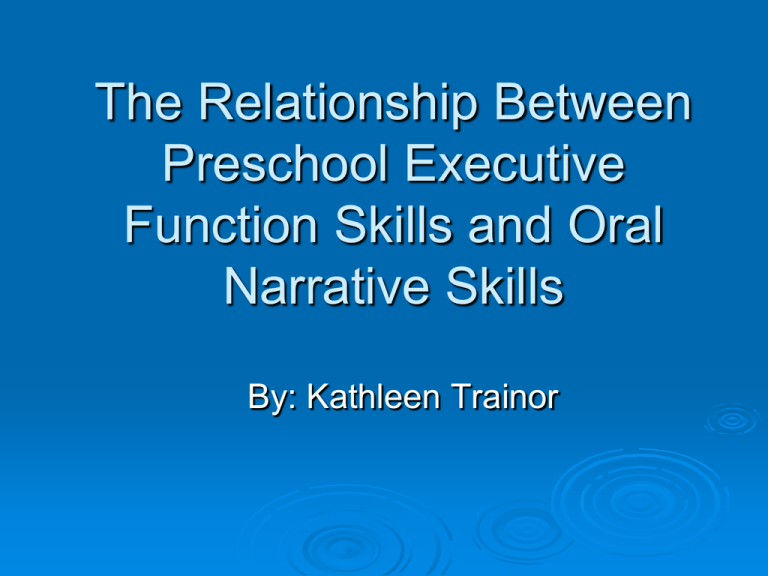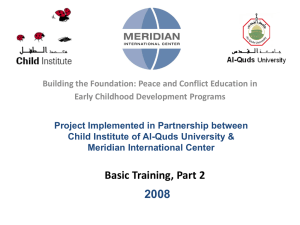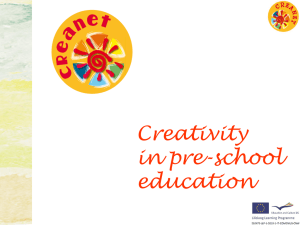The Relationship Between Preschool Executive Function Skills and
advertisement

The Relationship Between Preschool Executive Function Skills and Oral Narrative Skills By: Kathleen Trainor What are Executive Functions? High-Order Cognitive Operations Cognitive Processes Attention Inhibition Working Memory Components Goal Selection Planning/Organizing Initiation/Persistence Flexibility Execution/Goal Attainment Self-Regulation Development of Executive Functions Birth to mid-20s Preschool Executive Function Development Attentional Control Cognitive Flexibility Information Processing Goal Setting Executive Function Development In Preschoolers Senn, Espy, and Kaufmann (2004) 117 children: ages 2;8 – 6;0 4 executive function tasks measuring underlying cognitive processes and early EF components: Working memory (Delayed alternation task) Inhibition (Shape School) Flexibility (Spatial Reversal) Problem solving/planning (Tower of Hanoi) Path analysis used to identify correlation between these skills Results: Correlation between working memory and inhibition Working memory and inhibition were interpreted as key skills necessary for early problem solving NO correlation was found between early flexibility and early problemsolving/planning skills Executive Function Development in Preschoolers Isquith, Gioia, and Espy (2004) Authors previously developed the BRIEF, a rating scale of observable EF behaviors in children ages 5-18. Within BRIEF, EF behaviors converged onto 5 components: Inhibition, Shifting, Emotional Control, Working Memory, & Planning/ Organizing Development of preschool EF rating: Results: 201 children, ages 2-5 years Ratings of preschool children’s EF behavior by parents and teachers 5 EF components found in the BRIEF, converged into only 3 within the BRIEF-Preschool: Inhibition/Inhibitory self control index, Flexibility Index, and Emergent Metacognition Index Metacognitive abilities were poorly differentiated Executive Functions (& Language) Carlson, Davis, and Leach (2005) 101 typically developing children ages 3- and 4-years old PPVT-3 “Less is More” task Ability to inhibit initial response while holding rules in mind Altered pictures in order to establish importance of symbolic representation on inhibitory skills Results: Significant correlation between Less is More task and PPVT-3 3-year-olds were significantly less accurate in inhibiting initial response, in comparison to 4-year olds Executive Functions (& Language) Carlson (2005) 602 children, ages: 1;10 – 6;11 24 executive function tasks PPVT-3 Examined developmental progression inhibition and working memory Primarily inhibition and working memory Associated with expected language development Results: Significant relationship between scores on the PPVT-3 and number of EF tasks the children passed. Performance on majority of tasks showed significant age-related improvement on inhibitory and working memory skills Most difficult tasks for all age groups were those which combined inhibitory and working memory demands Research Questions What is the relationship between receptive vocabulary skills as measured by the PPVT and executive functions as measured by the parental report on the BRIEF–P ? What is the relationship between language skills in narrative form obtained from the Renfrew Bus Story and executive functions as measured by the parental report on the BRIEF–P? Subjects 19 preschool children: 12 male; 7 female Ages 4;3 to 5;3. Mean=4;10 Not previously diagnosed with a language disorder Attending a private preschool in Central Illinois Assessment Tools Peabody Picture Vocabulary Test-4 Receptive language Renfrew Bus Story Story retelling task: oral narrative • Informational Content • Sentence Length Behavioral Rating Inventory of Executive Functions – Preschool edition Parents’ rating of executive function ability • • • • Inhibitory Self-control Index – ISCI Flexibility Index – FI Emergent Metacognition Index – EMI Global Executive Composite – GEC T-scores of 65 and above indicate clinical significance/area of concern Results PPVT Renfrew Bus Renfrew Bus Renfrew Bus Information Content Sentence Length # of errors M=112 M=99 M=106 M=5 Range: 99-126 SD=19 Range: 75-129 SD=18 Range: 81-138 SD=17 Range: 2-10 SD=2 SS<85= clinical significance BRIEFGEC BRIEFInhibit BRIEFFlexibility BRIEFMetacognition M=49 M=51 M=50 M=50 Range= 34-79 SD=13 Range=36-91 SD=13 Range=35-83 SD=13 Range=36-75 SD=12 T Score >65= clinical significance Relationship between PPVT and Renfrew Bus Story PPVT Renfrew Bus Renfrew Bus Informational Content Sentence Length .49* .34 * Significant correlation at .05 level Relationship between PPVT and BRIEF-P Parent PPVT BRIEFGEC BRIEFInhibition - .21 - .03 No significant correlations BRIEFBRIEFFlexibility Metacognition - .24 - .33 Relationship between Renfrew Bus Story and BRIEF-P Parent BRIEFGEC BRIEFInhibition BRIEFBRIEFFlexibility Metacognition - .58** - .45 - .51* - - .66** - .55* - .59** - .77** Renfrew Bus Informational Content .63** Renfrew Bus Sentence Length *significant correlation at .05 level **significant correlation at .01 level Discussion Compared to past studies: Interpretations/Implications Functional language tasks, such as story telling and discourse, require not only basic language skills, but also executive function skills such as inhibitory control, working memory, flexibility, and planning. Limitations Did not find significant correlations w/PPVT and EF, as Carlson and Carlson et. al did in the past. However did find correlations between oral narrative language skills and executive function behavior, particularly for the EF components of working memory and planning. Small sample size Future Research Extend to larger sample size of preschool and school-aged children. Extend analysis to encompass children with various types of language disorders Consider means of identifying profiles of emerging EF skills relative to developing language skills. References Anderson, P. (2002). Assessment and development of executive function (EF) during childhood. Child Neuropsychology, 8, 71-82. Anderson, V. A., Anderson, P., Northam, E., Jacobs, R., & Catroppa, C. (2001). Development of executive functions through late childhood and adolescence in and australian sample. Developmental Neuropsychology, 20, 385-406. Carlson, S. (2005). Developmentally sensitive measures of executive function in preschool children. Developmental Neuropsychology, 28(2), 595616. Carlson, S., Davis, A., & Leach, J. (2005). Less is more: executive function and symbolic representation in preschool children. Psychological Science, 16(8), 609-616. Dawson, P., & Guare, R. (2004). Executive skills in children and adolescents. New York: The Guilford Press. Dunn, L., & Dunn, D. (Ed.). (2007). Peabody picture vocabulary test, fourth edition. Minneapolis, MN: Pearson Assessments. References Gioia, G., Espy, K., & Isquith, P. (Ed.). (2003). Behavior rating inventory of executive function - preschool version. Lutz, FL: Psychological Assessment Resources, Inc.. Glasgow, C., & Cowley, J. (1994). Renfrew Bus Story test - North American Edition. Centreville, DE: Centreville School. Isquith, P., Gioia, G., & Espy, K. (2004). Executive function in preschool children: Examination through everyday behavior. Developmental Neuropsychology, 26(1), 403-422. Jurado, M. B., & Rosselli, M. (2007). The elusive nature of executive functions: A review of our current understanding. Neuropsychology Review, 17, 213-233. doi:10.1007/s11065-0079040-z Richard, G. J., & Fahy, J. K. (2005). The source for development of executive functions. East Moline, Illinois: Linguisystems. Senn, T., Espy, K., & Kaufmann, P. (2004). Using path analysis to understand executive function organization in preschool children. Developmental Neuropsychology, 26(1), 445-464. Stuss, D. T., & Alexander, M. P. (2000). Executive functions and the frontal lobes: A conceptual view. Psychological Research, 63, 289-298.









